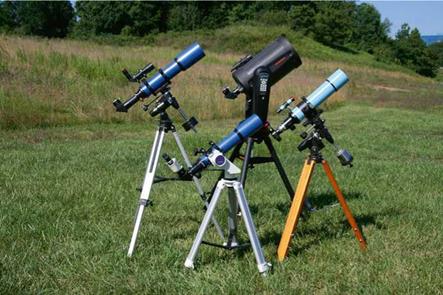The Telescopes
|
Fig. 2.1 Group photo of the author’s collection of telescopes. Courtesy of the author |
The world of astronomy is inhabited by a menagerie of telescopes. There are short – focus and long-focus refractors, Dobsonian reflectors, Schmidt – or Maksutov – Cassegrains, Newtonian reflectors, GOTO telescopes, achromats, apochromats,… the list goes on and on. There are telescopes of every size and for every budget. Some with manual altitude-azimuth mounts, some with German equatorial mounts, and some with very sophisticated electronic GOTO mountings. It’s no wonder that a person new to astronomy gets confused and intimidated.
The following discussions on telescope types demands a definition of focal ratio, or f/ratio. Quite simply, the f/ratio is the focal length of the telescope divided by the diameter of the main lens or mirror. The smaller the f/ratio, the lower the magnification and the wider the field of view with any specific eyepiece. Higher magnification is easily attained with a higher the f/ratio, but with the cost of a smaller field of view.
In order to simplify the world view of amateur astronomy, it is best to organize telescopes into the three basic categories: refractors, reflectors, and catadioptrics.











